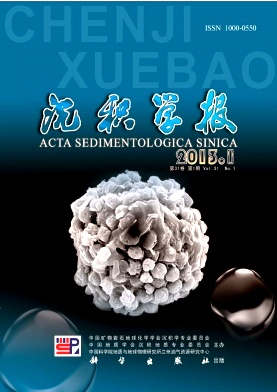Characteristics and Environmental Significance of the Chuanshan Formation Oncoids in the Majiaoba Area, Northwestern Sichuan Province
- Publish Date: 2013-02-10
-
Key words:
- oncoids /
- classification /
- forming environment /
- depositional environment /
- Chuanshan Formation /
- Majiaoba region /
- /
- /
- /
- /
Abstract: Oncoids are well preserved in the Chuanshan Formation in Majiaoba, Jiangyou County. Five types of core and lamina and three types of structures could be divided according to their microstructures. Five types of core are composed of bioclasts, intraclast, recrystallized bioclasts, pelletoid or early period oncoids and organic shell carbonate. Five types of lamina are commomly composed of sparry laminae, micritic laminae, clotlike laminae, micritic laminae including or alternating with layers of recognizable encrusting microfossils and porostromate laminae. Three types of structures are birdseye structure, micritization, layered structure and so on. At the same time, the relationship of the cores and laminas are discussed in the paper. The types of lamina are easy dominated by the type of core, especially the original shape of the core.Six oncoid types are distinguished by their cores, laminas and shapes, such as big ball oncoids(diameter>4mm), small ball oncoids(diameter 0.5~4 mm), longshaped oncoids(long axis and minor axis ratio>2), gibbous oncoids, irregular oncoids and combined oncoids. They are deposited in winnowed platform edge sands, open platforms or restricted platforms separately. Both the distribution of the oncoids and their forming and depositional environments are discussed in this paper. (1) Forming environments and depositional environments are inconsistent. Oncoids contents have big sizes and are cemented by sparites in the strata, laminas are more complex and thicker than cores, and constituents of core and matrix are different. The cores, which are deposited nearby open platforms with weak water power, suspended nearby winnowed platform edge sands with strong water power capturing and adhering carbonate particles. Additionally, biological clastics are seriously brokem in such samples. (2) Forming environments are not similar with depositional environments, at the same time the cores and the matrix are both composed by complete biological clasts. Medium spreaded oncoids contents have medium diameters and simple laminas and were cemented by sparites. Some biological clasts in their original places capture and adhere to carbonate particles during suspended in open platforms state. (3)Forming environments are exactly same with depositional environments. The oncoids are deposited in restricted platforms, with low contents,anomalistic diameters, polytropical edges, simple laminas, low biological clastic and thin laminas.
| Citation: | Characteristics and Environmental Significance of the Chuanshan Formation Oncoids in the Majiaoba Area, Northwestern Sichuan Province[J]. Acta Sedimentologica Sinica, 2013, 31(1): 1-9. |






 DownLoad:
DownLoad: